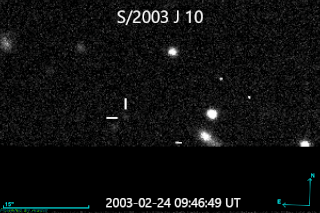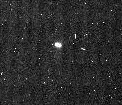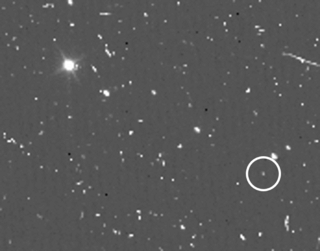Related Research Articles

Autonoe, also known as Jupiter XXVIII, is a natural satellite of Jupiter.

S/2003 J 2 is a retrograde irregular satellite of Jupiter. The moon was discovered on 5 February 2003 by a team of astronomers from the University of Hawaii led by Scott S. Sheppard and David C. Jewitt, and was later announced on 4 March 2003. It was initially thought to be Jupiter's outermost known moon until recovery observations disproved this in 2020.

S/2003 J 10 is a retrograde irregular satellite of Jupiter. It was discovered by a team of astronomers from the University of Hawaii led by Scott S. Sheppard et al. in 2003.

Narvi or Saturn XXXI is a natural satellite of Saturn. It was discovered by a team of astronomers led by Scott S. Sheppard in 2003, and given the temporary designation S/2003 S 1.
Fenrir, or Saturn XLI, is a natural satellite of Saturn. Its discovery was announced by Scott S. Sheppard, David C. Jewitt, Jan Kleyna, and Brian G. Marsden on May 4, 2005, from observations taken between December 13, 2004, and March 5, 2005. Fenrir has an apparent magnitude of 25, making it one of the faintest known moons in the Solar System, and was discovered using some of the largest telescopes in the world. It is even too dark to have been observed by the Cassini spacecraft when it was in orbit around Saturn, for which it never got brighter than approximately 17th apparent magnitude. Fenrir was named after Fenrisulfr, a giant wolf from Norse mythology, father of Hati and Skoll, son of Loki, destined to break its bonds for Ragnarök.

Fornjot or Saturn XLII is the outermost named moon of Saturn. Its discovery was announced by Scott S. Sheppard, David C. Jewitt, Jan Kleyna, and Brian G. Marsden on 4 May 2005 from observations taken between 12 December 2004, and 11 March 2005. It had the largest semi-major axis among all the known moons of Saturn
S/2004 S 7 is a natural satellite of Saturn. Its discovery was announced by Scott S. Sheppard, David C. Jewitt, Jan Kleyna, and Brian G. Marsden on 4 May 2005 from observations taken between 12 December 2004 and 8 March 2005.

Bestla or Saturn XXXIX is a retrograde irregular moon of Saturn. Its discovery was announced by Scott S. Sheppard, David C. Jewitt, Jan Kleyna, and Brian G. Marsden on 4 May 2005, from observations taken between 13 December 2004 and 5 March 2005.
S/2004 S 12 is a natural satellite of Saturn. Its discovery was announced by Scott S. Sheppard, David C. Jewitt, Jan Kleyna, and Brian G. Marsden on 4 May 2005 from observations taken between 12 December 2004 and 9 March 2005.
Aegir, also Saturn XXXVI, is a natural satellite of Saturn. Its discovery was announced by Scott S. Sheppard, David C. Jewitt, Jan Kleyna, and Brian G. Marsden on May 4, 2005, from observations taken between December 12, 2004, and March 11, 2005.

Bergelmir or Saturn XXXVIII is a natural satellite of Saturn. Its discovery was announced by Scott S. Sheppard, David C. Jewitt, Jan Kleyna, and Brian G. Marsden on May 4, 2005, from observations taken between December 12, 2004, and March 9, 2005.
S/2004 S 13 is a natural satellite of Saturn. Its discovery was announced by Scott S. Sheppard, David C. Jewitt, Jan Kleyna, and Brian G. Marsden on 4 May 2005 from observations taken between 12 December 2004 and 9 March 2005.

Bebhionn, also known as Saturn XXXVII, is a small, irregular natural satellite of Saturn. Its discovery was announced by Scott S. Sheppard, David C. Jewitt, Jan Kleyna, and Brian G. Marsden on 4 May 2005 from observations taken between 12 December 2004 and 9 March 2005.

Hyrrokkin or Saturn XLIV is a natural satellite of Saturn. Its discovery was announced by Scott S. Sheppard, David C. Jewitt, Jan Kleyna, and Brian G. Marsden on June 26, 2006, from observations taken between December 12, 2004, and April 30, 2006.
S/2006 S 1 is a natural satellite of Saturn. Its discovery was announced by Scott S. Sheppard, David C. Jewitt, Jan Kleyna, and Brian G. Marsden on June 26, 2006 from observations taken between January 4 and April 30, 2006. S/2006 S 1 is about 6 kilometres in diameter, and orbits Saturn at an average distance of 18.65 Gm in 951.1 days, at an inclination of 154.6° to the ecliptic, in a retrograde direction and with an eccentricity of 0.0814.

Kari or Saturn XLV is a natural satellite of Saturn. Its discovery was announced by Scott S. Sheppard, David C. Jewitt, Jan Kleyna, and Brian G. Marsden on 26 June 2006 from observations taken between January and April 2006.
S/2006 S 3 is a natural satellite of Saturn. Its discovery was announced by Scott S. Sheppard, David C. Jewitt, Jan Kleyna, and Brian G. Marsden on June 26, 2006 from observations taken between January and April 2006.

Loge or Saturn XLVI is a natural satellite of Saturn. Its discovery was announced by Scott S. Sheppard, David C. Jewitt, Jan Kleyna, and Brian G. Marsden on 26 June 2006, from observations taken between January and April 2006.

Skoll or Saturn XLVII is a retrograde irregular satellite of Saturn. Its discovery was announced by Scott S. Sheppard, David C. Jewitt and Jan Kleyna on 26 June 2006 from observations taken between 5 January and 30 April 2006.

Tarqeq, also known as Saturn LII is a natural satellite of Saturn. Its discovery was announced by Scott S. Sheppard, David C. Jewitt, Jan Kleyna, and Brian G. Marsden on 13 April 2007 from observations taken between 5 January 2006 and 22 March 2007. It is named after Tarqeq, the Inuit moon god, and is a member of the Inuit group of irregular satellites. It is about six kilometres in diameter. The Cassini spacecraft observed Tarqeq over 1.5 days on 15–16 January 2014.
References
- ↑ Discovery Circumstances from JPL
- ↑ Sheppard, S. S. (2019). "Moons of Saturn, Carnegie Science, on line".
- 1 2 Denk, Tilmann; Mottola, Stefano; Tosi, Frederico; Bottke, William F.; Hamilton, Douglas P. (2018). "The Irregular Satellites of Saturn" (PDF). In Schenk, Paul M.; Clark, Roger N.; Howett, Carly J. A.; Verbiscer, Anne J.; Waite, J. Hunter (eds.). Enceladus and the Icy Moons of Saturn. Space Science Series. Vol. 322. Tucson, AZ: The University of Arizona Press. pp. 409–434. Bibcode:2018eims.book..409D. doi:10.2458/azu_uapress_9780816537075-ch020. ISBN 9780816537075.
- ↑ Graykowski, Ariel; Jewitt, David (2018-04-05). "Colors and Shapes of the Irregular Planetary Satellites". The Astronomical Journal. 155 (4): 184. arXiv: 1803.01907 . doi: 10.3847/1538-3881/aab49b . ISSN 1538-3881.
- ↑ Tomatic, A. U. (8 October 2019). "MPEC 2019-T165 : S/2007 S 2". Minor Planet Electronic Circular. Minor Planet Center.
- ↑ Beatty, Kelly (4 April 2012). "Outer-Planet Moons Found — and Lost". www.skyandtelescope.com. Sky & Telescope. Retrieved 27 June 2017.
- ↑ Jacobson, B.; Brozović, M.; Gladman, B.; Alexandersen, M.; Nicholson, P. D.; Veillet, C. (28 September 2012). "Irregular Satellites of the Outer Planets: Orbital Uncertainties and Astrometric Recoveries in 2009–2011". The Astronomical Journal. 144 (5): 132. Bibcode:2012AJ....144..132J. doi: 10.1088/0004-6256/144/5/132 . S2CID 123117568.
- ↑ "Saturn Surpasses Jupiter After The Discovery Of 20 New Moons And You Can Help Name Them!". Carnegie Science. October 7, 2019.
- ↑ Sheppard, Scott. "Scott S. Sheppard - SaturnMoons". sites.google.com. Retrieved 7 October 2019.

